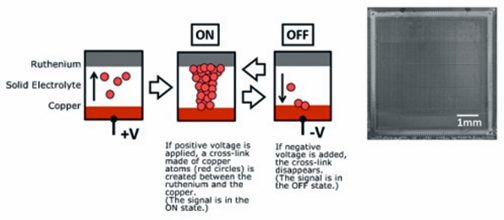
Specifically designed for use in space systems, NEC and the Japanese National Institute of Advanced Industrial Science and Technology (AIST) have developed an FPGA that possesses high radiation tolerance.
Typically, SRAM-based FPGAs when used in space can experience the problem of changes to the information written in the SRAM due to the effects of radiation, according to NEC. For example, radiation can cause an electrical charge in the semiconductor substrate. As a result, a failure occurs to the SRAMs in FPGAs that record information based on the amount of charge, causing a change in the circuit configuration.

The NanoBridge uses the cross-link of metal atoms in a solid electrolyte to place the signals into the ON or OFF state
NEC now claims their NanoBridge technology enables a tenfold improvement over the power efficiency of conventional FPGAs as well as providing them with high radiation tolerance. The company has conducted an operation demonstration jointly with the Japan Aerospace Exploration Agency (JAXA), using the newly developed NB-FPGA in a tough radioactive terrestrial environment. As a result, the ON and OFF states of the NanoBridge remain unchanged, whether radiation is delivered or not. The next step is to validate the NB-FPGA by incorporating it in the Satellite Technology Demonstration 1, which will be launched in FY2018.
Yuichi Nakamura, general manager at NEC Research Laboratories, wrote that based on the result, NEC expects that the NanoBridge will be able to reduce the frequency of errors caused by radiation to one percent or less and contribute to the creation of an LSI that offers high radiation tolerance and ultra-low power consumption simultaneously.

